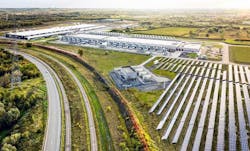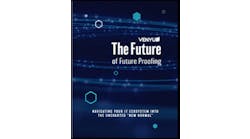Google will power its entire global information empire entirely with carbon-free energy by 2030, matching every hour of its data center operations to carbon-free energy sources, CEO Sundar Pichai announced today.
Google’s commitment will accelerate the data center industry’s shift to green power, as hyperscale operators seek to reckon with the impact of their operations on the global climate crisis. As some of the world’s largest energy users, cloud computing platforms possess the scale and buying power to reshape the supply chain for computing.
“We are the first major company to make a commitment to operate on 24/7 carbon-free energy in all our data centers and campuses worldwide. This is far more challenging than the traditional approach of matching energy usage with renewable energy, but we’re working to get this done by 2030.
“Not long ago, it was hard to imagine a 24/7 carbon-free electricity supply — at a simple level, the wind doesn’t always blow, and the sun doesn’t shine at night,” Pichai continued. “But thanks to trends in technology, and with the right government policies, the promise of 24/7 clean energy will soon be within reach. To get there, Google will invest in approaches that make it possible for us to source reliable carbon-free energy in all locations, at all times of day.”
A Data Center Team’s Vision
Pichai’s announcement marks Google’s formal embrace of an initiative within its data center team, which has been working since 2018 to use artificial intelligence and sophisticated energy provisioning to match its operations to carbon-free energy sources. This marks an ambitious step forward in using technology to create exceptional sustainability, as well as scale and speed.
Google data center executive Joe Kava outlined Google’s ambitions on round-the-clock clean energy last year (see Data Center Frontier’s coverage). In recent months, it has begun using sophisticated new software tools to create a carbon-intelligent computing platform, shifting large computing jobs to times where they can be powered with renewable energy.
To meet its goal, Google will also invest heavily in energy storage. Google’s announcement comes on the heels of a similar sweeping energy commitment from Microsoft, which plans to eliminate its reliance on diesel fuel by the year 2030, a decision that has major implications for its data centers around the world, many of which use diesel-powered generators for backup power.
Google and Microsoft are perhaps the world’s largest investors in data center infrastructure, and both companies intend to use their massive buying power to being fundamental change to their supply chain, creating an ecosystem that can power the economy with clean energy at scale.
“We’ll do things like pairing wind and solar power sources together, and increasing our use of battery storage,” said Pichai. “And we’re working on ways to apply AI to optimize our electricity demand and forecasting. These efforts will help create 12,000 jobs by 2025. Importantly, we think our work can accelerate the availability of clean energy in communities worldwide, and help to solve challenges that have held back its ability to become an around-the-clock source of energy.”
Analytics Make Power Matching Possible
Sustainability has been a huge priority for Google, which has been a leader in green innovation in the industry. Google has matched its electricity consumption with renewable energy purchases in each of the past three years, purchasing 1.1 gigawatts in 2019. Most of that green energy goes to support Google’s massive network of data centers, which power everything from YouTube videos to Gmail to every query you type into the search field.
Google can currently account for all its operations with energy purchases. But the intermittent nature of renewable energy creates challenges in matching green power to IT operations around the clock. Solar power is only available during daylight hours. Wind energy can be used at night, but not when the wind dies down. At present Google matches 61% of its hourly electricity usage with regional, carbon-free sources located on the same power grid as the company’s data centers.
“Without Google’s purchases of renewable energy this figure would have only been 39%, equivalent to the existing ‘grid mix’ in regions where we operate,” the company said in a white paper outlining its goals. However, these global averages mask significant differences both day-to-day and across sites. In Singapore, most grid electricity comes from natural gas, and our data center was only matched with 3% carbon-free energy. In breezy Oklahoma, on the other hand, our purchases of wind power helped drive carbon-free energy performance at our
data center to 96%.”
Understanding a data center’s energy usage on a granular level is not simple, due to the complexities of data center operations and utility grid systems. For Google, the first step was analyzing the electricity powering the company’s data center campuses on an hourly basis. To do this, Google created “Carbon Heat Maps” to visualize how well a data center is matched with carbon-free energy on an hour-by-hour basis.
In April it unveiled the next step in the process – a carbon-intelligent computing platform that optimizes for green energy by rescheduling workloads that are not time-sensitive, matching workloads to solar power during the day, and wind energy in the evening, for example.
Google’s carbon-aware platform currently focuses on shifting tasks to different times of the day within the same data center. The company also hopes to move workloads between data centers to boost its use of renewables, a strategy that offers even greater potential gains by shifting data center capacity to locations where green energy is more plentiful, routing around utilities that are slow to adopt renewables.
Renewable Energy Gets Way Cheaper
The next step is being able to provision enough renewable energy to address gaps in its green power supply. This is no longer a futuristic fantasy, Google says.
“Clean energy has come so far, so fast in recent years that it’s now possible to envision a new paradigm,” the company said in its white paper. “Google and many others have laid a foundation that will enable rapid progress in the years ahead. A major shift in energy production technology plays a big part in this
story.
“Crucially, we also believe we can reach our goal in a cost-effective manner, meaning other companies could quickly follow suit.”
Demand from hyperscale operators like Google, Microsoft, AWS and Facebook has helped bring efficiency to renewable energy markets, making clean power more affordable. The cost of wind and solar power declined by 70% and 89%, respectively, making them competitive with carbon-based energy in many markets. A similar trend has been seen in utility-scale batteries, where prices for storage capacity declined 76% between 2012 and 2019, Google said.
Energy storage can address some of the intermittency challenges for wind and solar power. But it must be accompanied by changes in the way energy markets operate. Google’s approach will include three strategies:
- Moving from single-source PPAs (power purchase agreements) to multi-source and multi-technology blended PPAs, including vendors generating wind and solar power, for instance.
- Creating utility programs to enable broader access to affordable clean energy, an area where Google has been active in several states.
- Developing new models where multiple users can share clean energy assets.
Google also noted that “carbon-free” energy sources include renewable energy sources such as wind, solar, geothermal, hydropower, and biomass, but also nuclear energy and technologies that capture carbon emissions and prevent them from being emitted into the atmosphere.
“We’re optimistic that by harnessing new technologies, investing in the right infrastructure and tools, and empowering partners, nonprofits and people, this can be the most decisive decade for climate action yet,” said Pichai. “We’re proud to do our part, and to help move the world closer to a carbon-free future for all.”






